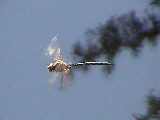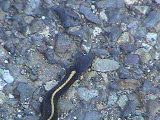 I am jumping on the Katrina bandwagon just long enough to point out that a protective barrier of wetlands would have greatly ameliorated the effects of said hurricane. At least now we can directly assign a dollar value to those wetlands we have destroyed, giving Bush’s economic advisors something to chew on. Maybe the next time someone suggests that saving and restoring coastal wetlands is cost-effective they will listen. Something good may come out of all of this, like carbon trading or an impeachment.Wetland preservation by the federal government has been a hot topic for the last couple of decades. Go to this US government site for the confused history (which reads like a Monty Python script). Note that Table 6 lists federal regulations encouraging wetland conversion, along with regulations discouraging or preventing wetland conversion, acquisitions discouraging or preventing wetland conversion, and other policies and programs preventing or discouraging wetland conversion — our tax dollars at work.
I am jumping on the Katrina bandwagon just long enough to point out that a protective barrier of wetlands would have greatly ameliorated the effects of said hurricane. At least now we can directly assign a dollar value to those wetlands we have destroyed, giving Bush’s economic advisors something to chew on. Maybe the next time someone suggests that saving and restoring coastal wetlands is cost-effective they will listen. Something good may come out of all of this, like carbon trading or an impeachment.Wetland preservation by the federal government has been a hot topic for the last couple of decades. Go to this US government site for the confused history (which reads like a Monty Python script). Note that Table 6 lists federal regulations encouraging wetland conversion, along with regulations discouraging or preventing wetland conversion, acquisitions discouraging or preventing wetland conversion, and other policies and programs preventing or discouraging wetland conversion — our tax dollars at work.
State governments have also been trying to preserve wetlands in their peculiarly inefficient sort of way. I’ll give you some examples. I watched my local government spend many hundreds of thousands of dollars carefully restoring a wetland that lies between Boeing Field and Interstate 5 as part of a road construction project. The wetland is only a few hundred feet long and maybe fifty feet wide. They spent millions more doing the same thing to wetlands a few miles away while building the new First Avenue Bridge.

The problem is that small isolated ecosystems go sterile in very short order. A case in point: I have a 400-gallon pond in my front yard. It is essentially a small wetland. Attempts to keep a breeding population of fish, frogs, turtles, salamanders, crayfish, or anything else that should be a part of a natural wetland would be futile. We continuously replenish the goldfish and guppies lost to cats, raccoons and herons. Even if the pond were too big and deep for predators to clean out in a single evening, it would still go sterile, just taking longer to do so.
That is because most forms of wetland wildlife (beavers, frogs, turtles, salamanders, snakes, dragonflies and the like) have a tendency to move around. It is a way of mixing genes. However, wandering out of your wetland in the middle of a big dirty city filled with millions of cars and cats is suicidal. New breeding stock is also not going to migrate into such a wetland.
 This proclivity for my local government to spend millions to maintain wetlands that have been isolated by many square miles of pavement is an incredibly inefficient use of wetland preservation funds. These are not parks. Few people even know they exist. Thousands of acres of intact, interconnected wetlands could have been purchased and protected with that money. Instead, it was used to beautify isolated mud holes in the middle of industrial wastelands. Any conservation organization worth its salt would have abandoned or sold those wetlands to focus on saving what was worth saving. This is called triage.
This proclivity for my local government to spend millions to maintain wetlands that have been isolated by many square miles of pavement is an incredibly inefficient use of wetland preservation funds. These are not parks. Few people even know they exist. Thousands of acres of intact, interconnected wetlands could have been purchased and protected with that money. Instead, it was used to beautify isolated mud holes in the middle of industrial wastelands. Any conservation organization worth its salt would have abandoned or sold those wetlands to focus on saving what was worth saving. This is called triage.
On the other extreme, I watched a guy clandestinely drain and destroy an acre of wetland in a rural area of Mason County this summer. He is working fast to get rid of the brush and plants that mark the area as a wetland so the feds won’t catch him. Lord knows I am trying to help them catch him but have to date failed to get the appropriate bureaucrat to call me back. This particular wetland is (was) used by thousands of emerald tree frogs every year for breeding.
 Also, a few weeks ago, I discovered a latrine on some private property a few hundred feet from an isolated beach. Puget Sound is in big trouble from failed and illegal septic systems. So why do I know of this outhouse I was not even looking for but the government does not?
Also, a few weeks ago, I discovered a latrine on some private property a few hundred feet from an isolated beach. Puget Sound is in big trouble from failed and illegal septic systems. So why do I know of this outhouse I was not even looking for but the government does not?
Finally there was this piece. The local government did good to buy the lake, but just spent $122,000 on a boardwalk. Aside from the fact that boardwalks take constant maintenance to keep them from rotting away, that much money in Kitsap County could buy about 60 acres of wetlands or undeveloped forest adjacent to wetlands. When a local government obtains funding for wetlands protection, they should think a minute as to how it might be more effectively used. I don’t mean to sound like a libertarian, but this is one of the underlying problems with government, inefficiency brought on by the absence of any profit motive.
 I am jumping on the Katrina
I am jumping on the Katrina 
